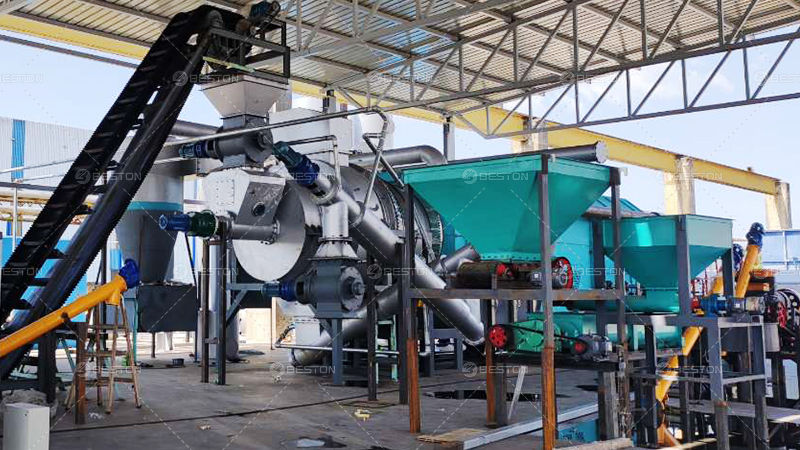The Role of Biochar Machine in Carbon Removal
- arbourz
- Mar 30
- 4 min read
Biochar production is a powerful technology for mitigating climate change through carbon sequestration. The process involves converting organic materials, such as agricultural waste, biomass, and even plastic, into biochar by heating them in the absence of oxygen in a device known as a biochar machine. The machine facilitates the transformation of carbon-rich materials into stable, solid carbon products that can be stored in the soil for centuries. This not only reduces the amount of carbon dioxide (CO2) in the atmosphere but also enhances soil health and fertility. Understanding how a biochar machine achieves carbon removal requires an exploration of its process, mechanisms, and the role of biochar in sequestering carbon.
Pyrolysis Process and Carbon Fixation
At the heart of the biochar machine’s functionality is pyrolysis, a thermal decomposition process that takes place in the absence of oxygen. During pyrolysis, organic materials are heated to temperatures ranging from 350 to 700 degrees Celsius. This heat breaks down the materials into volatile gases, liquids, and a solid residue — biochar. The key to carbon removal lies in the way that biochar retains the carbon originally present in the feedstock.
Unlike combustion, which releases carbon dioxide back into the atmosphere, the biochar production process captures and locks away carbon in a stable, solid form. The carbon within the feedstock is converted into complex structures in the biochar that resist further decomposition. The carbon atoms in the biochar are tightly bound within its porous structure, preventing them from being released back into the atmosphere for thousands of years.

Carbon Sequestration Potential
The sequestration of carbon in biochar is an essential aspect of its carbon removal capabilities. The carbon stored in biochar is not easily re-released into the atmosphere because the structure of the biochar is stable. As biochar is introduced into the soil, it interacts with the soil matrix, where it can further resist degradation. This long-term stability makes biochar an effective means of sequestering carbon over extended periods, potentially mitigating the effects of climate change for centuries.
Biochar’s ability to sequester carbon is further enhanced by its highly porous structure, which not only provides a large surface area for soil microbes to thrive but also reduces soil erosion. These benefits lead to increased soil fertility, further encouraging the use of biochar as a soil amendment in agriculture and land restoration projects.
Reducing Greenhouse Gas Emissions
Biochar production plays a role in mitigating greenhouse gas emissions beyond just carbon sequestration. During the pyrolysis process, volatile organic compounds (VOCs) and methane are produced as by-products. If not properly managed, these gases could contribute to global warming. However, modern biomass pyrolysis plant is equipped with advanced gas collection and condensation systems, allowing the capture of these gases for use as syngas or energy. The gas can be utilized to power the pyrolysis process itself, making it energy self-sufficient and further reducing the carbon footprint of the operation.
In addition, the absence of oxygen during pyrolysis ensures that the carbon content of the feedstock is preserved. This is a critical factor in limiting CO2 emissions, as traditional burning or composting of organic waste often releases significant amounts of greenhouse gases. By preventing the oxidation of carbon and transforming it into biochar, the biochar machine reduces the overall greenhouse gas emissions associated with waste disposal.
Biochar in Soil and Long-Term Carbon Storage
Once produced, biochar can be used as a soil amendment, where it contributes to both carbon sequestration and soil enhancement. As biochar is added to the soil, it interacts with microorganisms, increasing microbial activity and improving nutrient cycling. This results in improved soil structure, water retention, and fertility. The presence of biochar in the soil also inhibits the release of greenhouse gases such as methane and nitrous oxide, which are commonly emitted from soils under certain agricultural practices.
The carbon stored in biochar remains locked in the soil for long periods due to its stability. This contributes to the reduction of atmospheric carbon levels, providing a sustainable solution for addressing climate change. Studies have shown that biochar can sequester carbon for hundreds to thousands of years, making it one of the most permanent forms of carbon storage.
Environmental and Economic Benefits
The carbon removal capabilities of biochar machines offer a wide range of environmental and economic benefits. Not only do they provide a solution to carbon emissions, but they also help mitigate the environmental impacts of waste disposal. By converting biomass waste, such as agricultural residues and forest residues, into biochar, the biochar machine helps reduce the burden of waste accumulation in landfills or open burning, both of which contribute to air pollution and greenhouse gas emissions.
Moreover, the use of biochar in agriculture can improve crop yields and reduce the need for chemical fertilizers, leading to lower production costs and reduced environmental pollution. By providing a sustainable waste-to-product solution, biochar machines offer both environmental and economic value.
Closing the Carbon Loop
Biochar machines serve as a crucial component in the global effort to reduce atmospheric carbon concentrations. Through the pyrolysis process, they facilitate the transformation of organic waste into a stable carbon form that can be sequestered in the soil. This process, combined with the energy efficiency of modern biochar machines and their ability to reduce greenhouse gas emissions, contributes significantly to combating climate change. The use of biochar not only removes carbon from the atmosphere but also provides a long-term, sustainable solution for soil improvement and waste management.
In conclusion, biochar machines play a pivotal role in the fight against climate change by capturing and storing carbon in a stable form. The pyrolysis process effectively locks away carbon in biochar, which can be used as a valuable soil amendment while reducing harmful greenhouse gas emissions. Through these mechanisms, biochar production stands out as an effective strategy for achieving carbon removal and contributing to environmental sustainability.









Comments